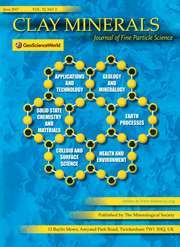Article contents
Clay minerals and the evolution of sedimentary rocks
Published online by Cambridge University Press: 14 March 2018
Extract
It has been estimated that nearly 50 per cent. of all known sedimentary rocks belong to the clay grade and it is therefore a hard fact that our knowledge of the mineralogical composition of approximately half the rocks of the stratigraphical column is still in a rudimentary state. The difficulties of petrographical work on clay grade sediments are all too familiar. The size of the individual particles is extremely small, often below the resolving power of the microscope. Most of the common clay minerals are biaxial and negative. Although minerals of the kaolinite group should be readily distinguishable from illitic and montmorillonoid minerals by their lower double refraction, films of iron hydroxide on individual particles or intimate admixtures of different minerals render observation difficult. In addition the presence of iron hydroxide films or changes in water content can give rise to variations in refractive indices. Petrographical work on clay minerals must be supplemented by other techniques which have been extensively developed within the last 20 years—X-ray analysis, thermal methods, the use of the electron microscope and certain chemical techniques. Despite the progress. which has been made, however, the day when quantitative estimations of the mineralogical composition of clay grade sediments can be rapidly and accurately made is still a long way off.
- Type
- Research Article
- Information
- Copyright
- Copyright © The Mineralogical Society of Great Britain and Ireland 1952
References
- 9
- Cited by


